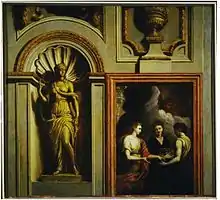
Louis Laguerre (1663 – 20 April 1721) was a French decorative painter mainly working in England.
Born in Versailles in 1663 and trained at the Paris Academy under Charles Le Brun, he came to England in 1683, where he first worked with Antonio Verrio, and then on his own. He rivalled with Sir James Thornhill in the field of history painting, primarily decorating the great houses of the nobility. His wall paintings can be found in Blenheim Palace, Marlborough House, Petworth House, Burghley House, Fetcham Park House and Chatsworth House. In the 1980s, a restoration project revealed work by Laguerre at Frogmore House also. His subject matter included English victories over the armies of Louis XIV; at Hampton Court Palace he carried out work for William III of England, for whom he depicted the Labours of Hercules.[1]
Laguerre painted religious subjects at St Lawrence's Church, Whitchurch, London.[2] In 1731 Alexander Pope wrote,
On painted ceilings you devoutly stare
which was taken by some contemporaries to be a reference to Laguerre's work for James Brydges, 1st Duke of Chandos at this church and the nearby Cannons House.
Laguerre was also a director of Godfrey Kneller's London Academy of Drawing and Painting, founded in the autumn of 1711. He died in London on 20 April 1721. His father-in-law was Jean Tijou.
Gallery of Laugerre's Work
 Julius Caesar sacrificing before going to the Senate, 1692-1694, oil on plaster - Painted Hall, Chatsworth House
Julius Caesar sacrificing before going to the Senate, 1692-1694, oil on plaster - Painted Hall, Chatsworth House Christ rising into Heaven, c.1688-1693 - Chapel, Chatsworth House
Christ rising into Heaven, c.1688-1693 - Chapel, Chatsworth House File:Christ healing the Sick, c.1688-1693 - Chapel, Chatsworth House
File:Christ healing the Sick, c.1688-1693 - Chapel, Chatsworth House An Assembly of the Gods, c.1688-1693 - State Drawing Room, Chatsworth House
An Assembly of the Gods, c.1688-1693 - State Drawing Room, Chatsworth House Phaeton and Apollo, c.1688-1693 - State Music Room, Chatsworth House
Phaeton and Apollo, c.1688-1693 - State Music Room, Chatsworth House Triumph of Diana, c.1688-1693 - State Bedchamber, Chatsworth House
Triumph of Diana, c.1688-1693 - State Bedchamber, Chatsworth House%252C_by_Louis_Laguerre%252C_c._1688-1693_-_State_Closet%252C_Chatsworth_House_-_Derbyshire%252C_England_-_DSC03233.jpg.webp) Judgment of Paris (Dispatch of the Apple of Discord), c.1688-1693 - State Closet, Chatsworth House
Judgment of Paris (Dispatch of the Apple of Discord), c.1688-1693 - State Closet, Chatsworth House Prometheus and Pandora, 1718–20, The Grand Staircase, Petworth House
Prometheus and Pandora, 1718–20, The Grand Staircase, Petworth House Murals with fictive architecture and portraits, c.1720, Saloon, Blenheim Palace
Murals with fictive architecture and portraits, c.1720, Saloon, Blenheim Palace The Triumph of the Duke of Marlborough, c.1720, Saloon ceiling Blenheim Palace
The Triumph of the Duke of Marlborough, c.1720, Saloon ceiling Blenheim Palace
See also
References
- ↑ Rubeigh James Minney (1972). Hampton Court. Cassell. p. 181. ISBN 9780304938414.
- ↑ "The Rise and Fall of James Brydges, Duke of Chandos".
- ↑ Epistle IV Archived 2009-06-06 at the Wayback Machine (Epistles to Several Persons: Epistle IV To Richard Boyle, Earl of Burlington)
Further reading
- Bénézit, Emmanuel (2006) [first published in French in 1911–1923]. Benezit Dictionary of Artists. Vol. 8. Paris: Gründ. p. 312. ISBN 2-7000-3078-8 – via the Internet Archive.
- Smith, Nicola (1996). "Laguerre, Louis". In Turner, Jane (ed.). The Dictionary of Art. Vol. 18. New York: Grove's Dictionaries. p. 644. ISBN 1-884446-00-0. OCLC 1033666240 – via the Internet Archive.
- Smith, Nicola (2004). "Laguerre, Louis". In Matthew, H. C. G. & Harrison, Brian (eds.). Oxford Dictionary of National Biography. Vol. 32. Oxford, New York: Oxford University Press. pp. 210–211. ISBN 0-19-861382-2. OCLC 1035750779 – via the Internet Archive.
- Waterhouse, Ellis K. (1978) [1953]. Painting in Britain, 1530 to 1790. The Pelican History of Art (4th ed.). Harmondsworth, England; New York: Penguin Books. ISBN 0-14-056101-3. OCLC 1245624144 – via the Internet Archive.
- Wescher, Paul (Autumn 1951). "Philippe Mercier and the French Artists in London". Art Quarterly. 14: 179–194 – via the Internet Archive.
- Whinney, Margaret; Millar, Oliver (1957). English Art, 1625–1714. Oxford History of English Art. Vol. 8. Oxford: Clarendon Press. OCLC 1150992276 – via the Internet Archive.